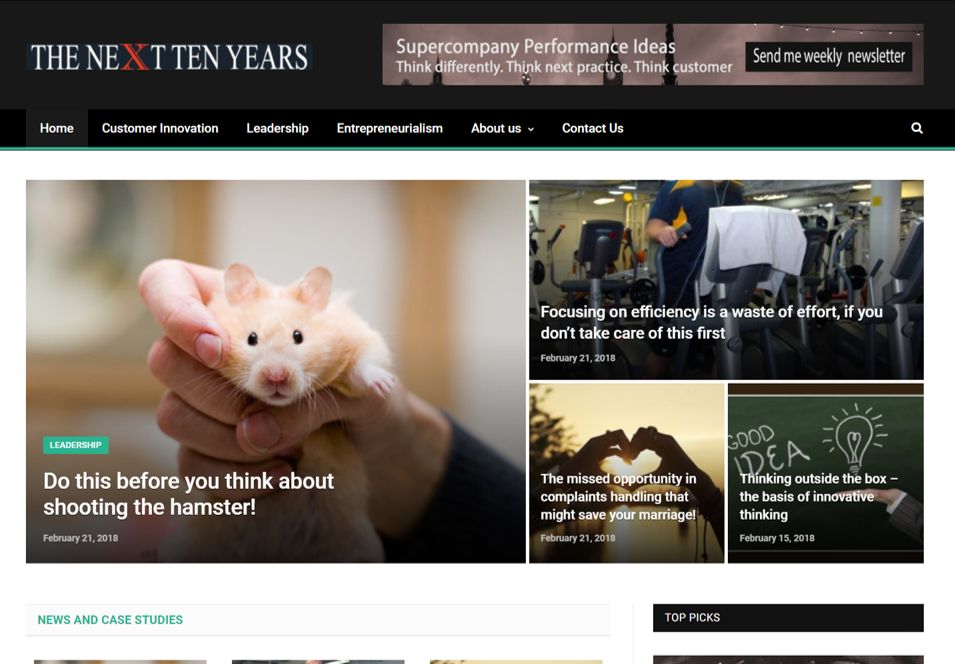Taking lessons from permaculture may be the best way to
create a sustainable culture change
As Kermit the Frog memorably put it, “it’s not easy being green”
as anyone will know who’s unwrapped and binned or attempted to recycle the
plastic from their weekly grocery shop. With images of plastic-bound sea life
in our heads we might be feeling a creeping sense of despair… So why apply
green principles to the equally vexed question of how to change your
organisation’s culture?
The short answer is that it makes a lot of sense to do so –
particularly if you want the change to be beneficial and long-lasting. Here’s
how…
Culture change – the perennial problem
I’ve lost count of the number of organisations I’ve sat in
where there’s an expressed wish that “if we could only change the culture” then
the desired change would happen or be a lot easier to make happen. This is a
common misconception: that culture is a “thing” that can be changed, like a
process or an IT system. It’s not: it’s a consequence of people and systemic
issues such as reward mechanisms, recruitment and so on. Affecting culture
requires an understanding of these various factors and their interplay but very
often leaders prefer a dramatic intervention such as replacing the top team or
laying off staff to achieve what are inevitably short-term benefits.
Something more sophisticated is required and rather than
come up with my own patented fool-proof culture change method (lubricated with
several litres of snake-oil) I’d like to propose the application of some existing
principles that will make you think more deeply about the impact of the change
you are effecting.
These principles come from a sustainability approach called
permaculture. In summary, permaculture – the name derives from “permanent
agriculture” and “permanent culture” – is an approach to living
that has less of a detrimental approach to the planet. In a discussion with
some friends about the topic recently I was struck by how relevant these were
to organisational change.
Principals for permanence
Permaculture is based on 12 design principles. There are
plenty of good summaries around
which are worth looking at. Here’s my take on how they might apply in a
commercial organisation
1. Observe and interact
It’s so tempting – particularly if you’re a consultant or a
leader operating on a tight timescale – to come up with solutions quickly and
implement them as rapidly as possible. Taking time to engage and understand an
organisation is critical if you want to identify the points of resistance and,
more importantly, the areas of support that will be important in making the
proposed change stick.
2. Catch and store energy
In pure agricultural terms this is another way of saying “make
hay while the sun shines” – an old saw but often overlooked when implementing
change. What are the best times to introduce a change (clue: probably not when
you’re doing annual appraisals)? Where are the areas of organisation with more energy
and support for the change you want to introduce (hint: start with these
first).
3. Obtain a yield
The reason we do agriculture is that we need our efforts to
yield something. Sustainable culture change in an organisation is the same: we
need to understand the benefits of what we are doing, whether hard financial
measures or softer attitude surveys. Having a good benefits management
discipline really helps here.
4. Apply self-regulation and accept feedback
In the permaculture context, self-regulation means putting
in the appropriate feedback loops so that a system can continue to function
well. In an organisational context, this fits well with continuous improvement
approaches such as Kaizen, or the application of systems theory. Understanding
what feedback mechanisms – formal and informal – regulate an organisation’s
behaviour and then altering them gradually is key to sustainable change.
5. Use and value renewable resources and services
The
Shock of the New was an acclaimed TV series on modern art but I think the
title could often be applied to approach used to create a shift in an
organisation’s culture, whether it’s “new” concepts (like customer-centricity –
mea culpa) or new customers, people, technology or processes. Introducing
something new consumes resource (it’s more expensive to acquire new customers
than to keep existing ones) whereas it’s better to reduce unnecessary
consumption where possible: what existing value is locked up in current
customers and people and how can you unlock it?
6. Produce no waste
Permaculture emphasises valuing and making use of all available
resources. Leaving aside my concerns about how much packaging goes to waste, businesses
are incredibly wasteful of the talent that’s locked up in their people and the
goodwill of their customers. Take a “zero waste” mindset to your business see
how it changes your perception of how to create value.
7. Design from patterns to details
This is one of the more obscure permaculture principles but it’s
intended to force thinking about the big picture in environmental terms.
Effective change management definitely takes this approach – at least in theory
– by stepping back and observing how processes work (or not) end-to-end and
asking the question “who do they serve?” (clue: if the answer is “the customer”
that’s a good thing).
8. Integrate rather than segregate
My gardening knowledge is limited but I do know that if you
plant marigolds amongst your tomatoes the chance of them being attacked by harmful
root-rotting nematodes is reduced. Permaculture emphasises putting things in places
where supportive relationships develop. How often do we do the opposite in organisations
and intentionally create barriers and internal competition?
9. Use small and slow solutions
As someone who cut their consulting teeth in the heyday of business
reengineering – the father of which, Michael Hammer, was fond of saying “if it ain’t
broke, break it” and where “big change, fast” was the guiding mantra – the idea
of being small and slow is anathema to me. However, it’s worth considering how
much attrition was caused in those swashbuckling reengineering projects and whether
the changes were sustained in the long term.
10. Use and value diversity
In agriculture, diversity increases resilience to disease
and with the commendable advent of diversity programmes across many organisations,
we might think we’re ticking this box. I don’t think we’re there yet: bringing different
points of view and thinking styles together constructively to solve business
problems is valuing diversity not just ticking a compliance box.
11. Use edges and value the marginal
Once again, my knowledge of sustainable agriculture leads me
to take at face value the permaculture claim that the interface between things
is where the most interesting events take place but in businesses that’s
definitely true, with the interface with customers the most productive area for
change and innovation. The problem is that this marginal area is often not
valued by organisations, leading to cultures that don’t place the customer at
the centre of what they do.
12. Creatively use and respond to change
Finally, the most powerful principle of the twelve. Change managers
like me might think that we are driving change (other powerful adjectives are
available) but it’s more helpful to think of how we respond to change. The
author William Bridges, in his book Managing Transitions, recognises
this: change is a sudden thing and it’s how we manage the transition to the new
state that results that’s important. Taking a creative and constructive view of
change events helps that transition.
It’s not easy…
Some of the principles may seem like the blindingly obvious,
some a little obscure, but they strike me a setting a challenge for all of us
engaged in organisational change: how do we carry it out in a way that
increases the chances of sustained benefits? Using the principles to ask
questions of and challenge our preconceptions about how change is managed will,
I believe, result in change that benefits all of us.
As Kermit says, it’s not easy being green…
Acknowledgements: 1) the author would like to thank his friend
Linda Murgatroyd for introducing him to the concept of permaculture 2) the author
also recognises that Kermit the Frog was singing about his skin colour not the
environment.





 If you have been following this series closely you’ll be equipped to build great relationships with your customers and be able to motivate your co-workers with a few killer one-liners and some well thought-out communications. There’s just one thing that needs to be added to spice up the workplace: circus skills. Yes, this is my big take-away from the Fringe: the business world would benefit enormously from regular injections of acrobatics, tightrope-walking and attempts at the seemingly-impossible.
If you have been following this series closely you’ll be equipped to build great relationships with your customers and be able to motivate your co-workers with a few killer one-liners and some well thought-out communications. There’s just one thing that needs to be added to spice up the workplace: circus skills. Yes, this is my big take-away from the Fringe: the business world would benefit enormously from regular injections of acrobatics, tightrope-walking and attempts at the seemingly-impossible. I’m going to tell you a story… no, I’m going to start with a confession – I don’t go to that many comedy shows so what I’m going to say is based almost entirely on the few shows I saw at the Fringe. But, as we consultants say, two data points make a trend and anything more than that is cast-iron proof. Oh, and I’m also going to attempt some humour… what’s that? People heading for the door? And I’ve only just started…
I’m going to tell you a story… no, I’m going to start with a confession – I don’t go to that many comedy shows so what I’m going to say is based almost entirely on the few shows I saw at the Fringe. But, as we consultants say, two data points make a trend and anything more than that is cast-iron proof. Oh, and I’m also going to attempt some humour… what’s that? People heading for the door? And I’ve only just started… I’ve been working in financial services on and off over a period of more than 20 years and the debate over how many branches a bank needs has been going on for at least that long. So it was good to see the
I’ve been working in financial services on and off over a period of more than 20 years and the debate over how many branches a bank needs has been going on for at least that long. So it was good to see the